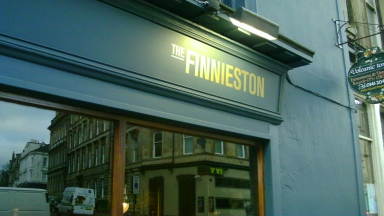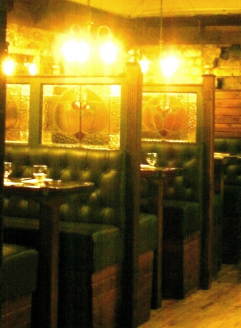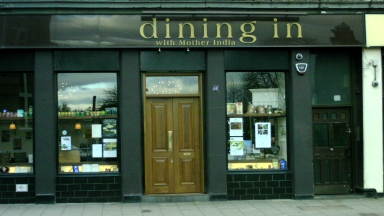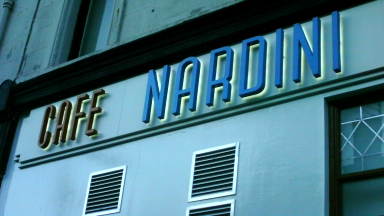Finnieston style
Added on Monday 20 Feb 2012
 It hasn't been open very long, but a quick visit to The Finnieston in west end Argyle Street the other day made me think I really ought to get out more - and certainly to the area that regularly gets played up as "the new Byres Road".
In fact I think that label is getting to be a bit past its sell-by date, as Argyle Street is cutting a distinctive dash of the sort that deserves a bit more than glib comparisons with the best known road in Hillhead.
It hasn't been open very long, but a quick visit to The Finnieston in west end Argyle Street the other day made me think I really ought to get out more - and certainly to the area that regularly gets played up as "the new Byres Road".
In fact I think that label is getting to be a bit past its sell-by date, as Argyle Street is cutting a distinctive dash of the sort that deserves a bit more than glib comparisons with the best known road in Hillhead.
In no particular order there's the whole clutch of venues at the museum end of the road, including Firebird, Green Chillies, Banana Leaf and The Goat, but whereas once that was about the extent of the action until you got much closer to town that has changed out of all recognition in the past six months. Fanny Trollope's is again deservedly top-tipped by The List as one of the best places to eat in Glasgow; there's the Athena Greek restaurant, Korean restaurant Shilla, the Brass Monkey pub (with a stunning design fit and products to match); the Neighbourhood Bar, and also Lebowski's - to name just some of the more obvious attractions.
But just as it may have seemed things couldn't get much better along comes "The Finnieston" on the unusual site of what had been a short-lived Russian venture, Cafe Bayan, and to my jaundiced eye it's little short of remarkable.
It certainly counts as "new wave" in Glasgow terms, despite some fairly interesting new venues that have opened recently, and immediately poses the basic question - is it a pub or a restaurant?
One online pubs pundit reckons it's overwhelmingly a restaurant, and claims people who are just in for a drink or two won't get the same service as diners out to spend possibly substantial sums on a full a la carte experience - and given it's not a big place there may be some truth in that argument.
But then again as a place to drop in for a relatively short-stay aperitif it is well worth half an hour or an hour of anyone's time - with the option of dining in style from any of the small dishes and sides selection on the menu (there's an £8 deal allowing you to combine one small dish with one side, which sounds excellent value).
Not only is it a "restaurant", it's emphatically a fish and seafood restaurant, as evidenced by the full menu. This is replete with sumptuous-sounding dishes based on produce from Gigha, Colonsay, and all sorts of other exotic west coast and Hebridean locations.
The "small plates" set the scene with choices like South Uist cold smoked salmon and Inverlochy goat's cheese - this is a place which clearly takes the whole concept of "provenance" very seriously indeed, so while there's a generic "west coast fish pie" - which seems to be a house speciality - most of the main dishes, as in roast Isle of Gigha Halibut, are a precisely named celebration of Scottish seafood at its most authentic.
There is a copious wine list to match the cuisine, including a choice of no less than six dessert wines, and everything about the way the offer is framed screams "quality" of the sort that should be investigated without delay.
As far as I'm aware none of the better-known magazine reviewers have been along to try their forensic skills on the food offer - perhaps they're bemused by the idea of a quality restaurant operating in a "pub" - but The Finnieston has all the apparent makings of a unique and even boutique speciality venture that should really be attracting major attention.
If the place sold nothing in the way of food beyond salt and vinegar crisps it would still be extremely interesting, thanks to the utterly gorgeous design job its owners have created - as special in its own way as the splendid interior of the nearby Ben Nevis pub, and very empathetic to the style of that fantastic local pub.
 One Edinburgh magazine has reviewed The Finnieston, and claims it resembles some sort of fishermen's inn (of the sort you might expect to encounter in coastal East Lothian, perhaps).
One Edinburgh magazine has reviewed The Finnieston, and claims it resembles some sort of fishermen's inn (of the sort you might expect to encounter in coastal East Lothian, perhaps).
But this does not do it justice, and sort of hints at an interior scheme based on whitewashed walls, anchors, nets, and all of that other maritime kitsch. What we're actually offered is a magnificent if understated decor which uses all of the original building's original charm to maximum effect.
The low-level interior, with its distinctive window sett and intricately pargeted ship-cabin ceiling, beautifully complements the style of a building dating from perhaps the late 17th century, if not before.
It reputedly once played host to Rob Roy MacGregor during his trading trips to Glasgow - sounds outrageous, but it's such an obviously historic building, so very different from every other structure around it, there may well be a grain of truth in there.
Booths divided by stained glass partitions, rugged exposed stonework and subtle lighting all create a subtle alchemy which makes the venue attractive enough by day but absolutely beguiling by candlelight.
There is, in fact, a thumping great anchor image on the door - but nicely done, and set off nicely by a brass ship's wheel "doorknob" which adds a little nautical flavour without going .... overboard.
Without having yet tasted a single morsel it's nevertheless fair to say this is one of the most imaginative ventures to arrive in the wider West End area over the past year, and a very worthy addition to an already fascinating scene. Much more, inevitably, on the food and other aspects in a future column.
 The Door of the Den at Dining In at Mother India's
The Door of the Den at Dining In at Mother India's
Meanwhile back on the stretch opposite Kelvingrove one of my favourite Indian restaurants is now sporting a brand new door, replacing the previous glass one with a solid high-quality wooden job.
It looks terrific, and very classy, but there's a small problem - and the owner may not necessarily thank me for pointing it out: it makes the place look shut. I called by in search of a carry-out last week and my heart promptly sank when I saw this door. Perhaps, I thought, things were quiet and they'd just decided to close for the day.
However on getting closer I could see enough through the windows to detect human activity inside, and on gingerly pushing on the wooden door peered through to realise that the restaurant was in fact operating normally.
The charming lady serving the takeaway counter confirmed what I thought about the door. Loads of regular customers also think the place is closed, and it's possibly a minor snag.
But of course once you've found out it's just a new door everything's fine - and as usual every visit is a joy.
Apart from the option of dining in, there's the characteristically stunning array of take-home dishes to choose from, along with a very nice range of accompaniments.
So far as I'm aware this venue is the only place that offers little appetiser tubs of accompaniments such as mango chutney, plum chutney and lime pickle (as well as very tasty spiced onions) for a very few extra pennies: the raita yoghurt, meanwhile, is delectable and I buy it whenever it's available.
 Twice as Nice
Twice as Nice
For quite a few months the Byres Road site of the former Morton's cafe had been covered in wooden hoardings while work slowly carried on inside on a brand new project - one set to bring one of the most iconic names in catering to the heart of the West End.
Nardini's of Largs is the most famous name in ice cream, north of the border. There are several other Italian names we could conjure with - Boni from Edinburgh, for example (I once knew the late Mario Boni, many years ago, while part of a history group - he was an authority on the battle of Bannockburn); Crolla, and - very near home - Colpi.
However I'm pretty sure most would agree the Nardini name is in a league of its own, not so much as an ice cream manufacturer as the name behind what many see as the ultimate art deco ice cream palace down at Largs.
More recently the familiar Nardini brand has to some extent been twinned with that of a relative new kid on the block.
Tony Macaroni, originally based in East Kilbride (it's a brand name - just like "Colonel Saunders"), has enlarged its frontiers by opening several spin-off ventures around the country, and in particular at the bottom of Byres Road where, in close proximity to Mexican newcomer Pinata, it does its Latin thing with considerable verve: where else would you see a red Masarati parked outside on a regular basis?
Now the two brand names are to be brought together in a venture I suspect will sweep the boards. In Nardini's Cafe we can look forward to the scintillating desserts which have become legendary down through the generations, and also a pizza and pasta hot food back-up courtesy of Tony Macaroni.
Nardini is no ordinary name in Italian ice cream parlour circles, and we can be guaranteed an interior decor design worthy of its prestigious heritage, but I suppose most people who love the ice cream parlour concept will be mainly interested in the bill of fare.
So whereas Gibson Street was once chiefly famous for its collection of Indian restaurants Byres Road appears to be gradually "going Italian" - Paperino's, Little Italy and La Vita Spuntini (as well as Tony Macaroni) are all well-established and apparently trading well.
To these we can add the illustrious University Cafe, which as I've noted before has a particular Italo-Scottish style that simply cannot be improved upon or replicated in any way - it's "part of the furniture" of the West End and should probably have some sort of historic monument status.
Put all of these places together and you have one very Italo-friendly road, with plenty of variety to choose from among recognisably different approaches to one of the world's premier league cuisines.
Will there be a shudder of angst from Three Steps to Heaven, just a few doors away from the new Nardini's Cafe?
I doubt it. Of course it has built its success on the quality of its ice cream as much as anything, but there's more to the place than a '99 or a Sundae, and in any case - and even in a recession - I think there's boundless enthusiasm for the concept of a cafe based largely on coffees and desserts.
Boldly going
Nice to see Stravaigin in Gibson Street continuing to extend the culinary frontiers by pulling off another special anniversary event on Thursday (February 23) - this time commemorating the celebrated scientist and author of the famous "Origin of Species", Charles Darwin.
Of course over the last few weeks there have been commemorations for another Victorian Charles - Charles Dickens - but he doesn't get a look in at this bash, perhaps because he's too readily associated with that workhouse classic, the bowl of gruel.
Oddly enough, porridge is "in" - for reasons which completely escape me - but maybe not of the Oliver Twist variety.
According to a telly programme I saw the other day Victorian steamed puddings are also back in a big way, but they're not my idea of fun either. Charles Darwin, on the other hand, is a brilliant theme for an adventurous restaurateur. In what's called a Phylum feast, Stravaigin has paid tribute to the celebrated botanist's memory by concocting dishes with product derived from as many species as possible - more than 50, in fact.
The five-course oddball feast includes such delights as beetles, and after dinner mints made with ants.
Apparently Darwin was a renowned gourmet who presided over the Glutton Club at Cambridge, a weekly meeting of like-minded eccentrics who tried to sample as many different animals as possible. Armadillo, puma, iguana and giant tortoise were typical offerings on the bill of fare - although whether as stews, burgers or curries isn't spelled out.
But here's a nice thought. Just last year Darwin's personal giant tortoise - named Harriet - finally passed away, having spent her last remaining years in a pleasant marine reserve in Queensland - comfortably outdoing by several lifetimes the boffins who might have eaten it, given half a chance. Harriet, hailing originally from the Galapagos Islands, was 176 years old
Soba so good
Yet another Byres Road venture has gone - but only to be replaced by another in the twinkling of an eye.
For what seemed like years the former Whistler's Mother pub-restaurant lay vacant as would-be suitors for the lease fought an apparently losing battle to gain a workable lease deal, and The Blind Pig eventually opened just as it appeared nothing else would ever happen there at all.
Gothic black and candlelit, it proved an instant success - although the food got mixed reviews - and appeared set to stay the distance, bolstered by an imaginative take on cocktails.
Now, in a flash, it's no more. Owner Brad Stevens has arguably pulled off a master-stroke by taking all the good elements of Blind Pig and combining them with the raved-about noodle cuisine of his Soba venture in town. It's yet another telling illustration of the fact that "pubs" and "restaurants" are no longer always separate concepts any more.
There have been cafe-bars around for years, but perhaps particularly since the launch of the new Licensing Act there's been a small revolution in bars - as witness The Finnieston.
So when you consider "noodle bars" are wildly popular, it's perhaps unsurprising that someone who's made a success out of oriental and fusion concepts should consider rolling it into what we'd once have called "a pub".
The billboard offers outside look interesting, and the interior is alluring - so I'll look forward to trying out the concept very soon.







